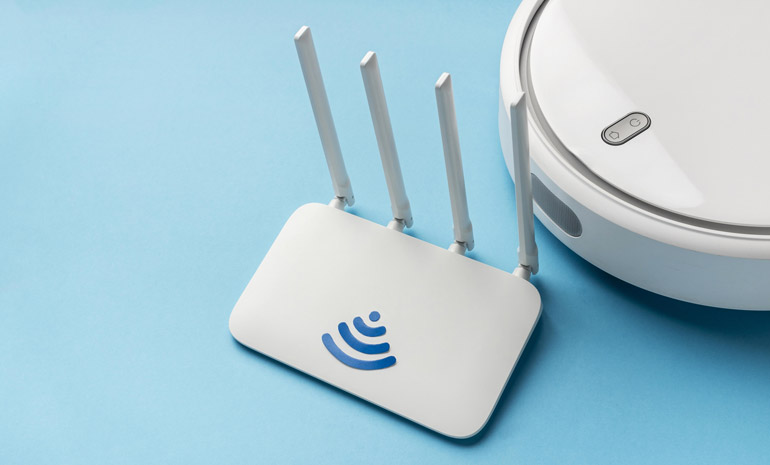
Wireless Access Points WiFi Solutions
In Networking, a wireless access point, or more commonly just an access point (AP), is a networking hardware device or technology that allows other WiFi devices to connect to a wired or wireless network. As a standalone hardware device, the Wireless AP may have a wired connection to a switch or router, but in a wireless router, it can also be an integral technology present inside the router itself. A Wireless AP is differentiated from a hotspot, a physical location where WiFi access is available. WiFi technology has significantly improved recently, but it's not one-size-fits-all, especially for businesses. Large office spaces with heavy network traffic typically utilize WiFi access points.
Wireless AP Features:
- WiFi-6, Future Ready: Get ready for a WiFi-6 experience. WiFi-6 Access Points offer blazing-fast Internet experiences, lesser congestion in high-density deployments, and greater channel capacity for seamless data transmission.
- Consistent WiFi Performances: Unparalleled performance and pervasive coverage for superior connectivity.
Access points that deliver high throughput and performance. - Value for Money: Pay the right price for the correct set of features WiFi gear that is affordable and designed to fit every deployment scenario
- Advanced Features: Packed with all advanced enterprise features Delivers seamless coverage and high performance for corporate networks
- Functional & Ergonomic Design: Intelligently designed access points are built for consistent performance, with easy, multiple mounting setups for indoors and outdoors with plug-and-play.
Designed for deployments at any venue - High-Performance Wireless: Superior technology meets the demands of modern enterprise networks and delivers speed and performance to wireless endpoints, thus providing an unmatched browsing experience.
- Flexible Management Options: Centrally manage all remote access points either using on-premise or cloud controller. Make configuration and monitoring seamless for your IT administrators.
- Zero Touch Provisioning: All Access points can be configured using centrally configured profiles, making deployments easy and cost-effective.
- PoE Enabled: Access Points use the latest PoE standard 802.3 af/, which enables easy deployments, saving deployment costs. Each Wireless AP can be powered through a DC adapter or a PoE switch.
- Hotspot Enabled: All Access Points have a built-in hotspot controller and can be easily deployed for public WiFi hotspots. Save the cost of an on-premise controller.
- Functional Designs: Access Points have Ergonomic designs that blend with the venue's aesthetics and are easy to install and maintain.
- Long Range: Provide comprehensive coverage to cover far-reaching areas with a reliable WiFi signal. Built-in power amplifiers help deliver connectivity in harsh RF environments.
- Security built-in: Encrypted threats are the new normal. Design an intelligent network with the help of an Access Point that can detect and help stop any threats.
- IoT-ready: Wireless AP can Monitor and manage devices and IoT sensors with a comprehensive on-premises or cloud dashboard.
- Above-and-beyond reliability: Go beyond basic connectivity and security. Build a robust WiFi 6/6E network that works for you.

Common types of wireless access points include:
- Indoor Access Points
- Outdoor Access Points
- Controller-Based Access Points
- Standalone Access Points
- Cloud-Managed Access Points
Advantages of Using Wireless Access Points:
- FLEXIBLE NETWORKING: Wireless APs provide greater flexibility in device placement by eliminating the need for physical cables, which facilitates easy access to the network from all locations within the coverage area.
- SIMPLIFIED NETWORK INFRASTRUCTURE: The reduced need for physical connections simplifies the network infrastructure. This is especially beneficial in places where running cables is impractical or inaesthetic.
- MOBILITY AND ROAMING: Wireless APs support roaming, which ensures seamless transitions between different Wireless APs as users move from one area to another. This allows users to move within the coverage area without losing connectivity.
- More User Access: Usually, the wireless router allows 10 – 20 devices or users to access the network, while the Wireless AP allows 50 – 100 or more devices or users to access the network.
The Wireless AP has a more vital ability to send and receive signals, which enables high usage. - Broader Transmission Range: A wireless router's signals cover 10 -12 meters, while a wireless access point covers 100 – 300 meters.
The broad range is supremacy for large covered offices or buildings for bigger businesses. With this wireless access point, users can easily roam in the larger area of the network.
Other Advantages:
- Business-grade access points can be installed anywhere an Ethernet cable can be run. Newer Wireless AP models are also compatible with Power over Ethernet Plus, or PoE+ (a combination of Ethernet and power cord), so running a separate power line or installing an outlet near the access point is unnecessary.
- Additional standard features include Access Control List (ACL) and Captive Portal support, which allow you to limit guest access without compromising network security and easily manage users in your organization within your WiFi network.
- Select access points include a Clustering feature—a single point from which an IT administrator can view, deploy, configure, and secure a WiFi network as a single entity instead of a series of separate access point configurations.
- Wireless APs are a secure, more convenient, and cost-efficient alternative to using cables and wires to connect computers or devices in a network. Setting up a wireless network with Wireless APs can provide many advantages for an organization.
- Wireless APs eliminates the need for physical cables, providing greater flexibility and mobility. Users can connect to the network from anywhere within Wireless AP's coverage area. Secondly, it simplifies network setup, as you do not have to run Ethernet cables to every device. Additionally, Wireless APs support multiple devices simultaneously.
Frequently asked questions
If a router cannot accommodate any more wireless devices, you can increase the device capacity by adding an access point instead of a second router. Wireless APs can support up to 250 devices, but a figure of 30 is more realistic in a real-world scenario, depending on the brand and model.
Access points are also helpful in ensuring full network connectivity is available across the office premises. You can use multiple Wireless APs to cover every part of the office.
Wireless APs can also increase a WLAN's signal range and strength. Strategically placed Wireless APs offer complete wireless coverage and eliminate "dead spots," especially in large office spaces, conference centers, hotels, and resorts.
It is a hardware device that creates a WLAN (Wireless Local Area Network) over a large area.
It connects users in large offices or enterprises, allowing them to roam easily anywhere in the area and be connected to a network.
LAN: LANs can also be provided in public places such as coffee shops, restaurants, airports, etc.
Wireless Printing: Wireless printers can be connected to the network, and users can print anywhere within the range of the access point.
Cloud services: Wireless access points can connect devices to cloud services, allowing for data backup and synchronization across multiple devices.
While a Wireless AP and a router are network devices, they serve different purposes. Wireless AP focuses solely on providing wireless connectivity within a network. It allows devices to connect wirelessly to a network and access its resources. On the other hand, a router is responsible for connecting multiple networks, such as your home network and the internet. It manages the data flow between these networks and assigns internet protocol (IP) addresses to connected devices.
Yes, You can use multiple Wireless APs in your network to extend the wireless coverage area. This is often called a wireless network "mesh" or "mesh networking."
The range of a Wireless AP depends on various factors, such as the specific model, the environment, and any potential obstacles. In general, the range of a typical Wireless AP can vary from around 100 to 300 feet indoors. However, remember that walls, furniture, and other objects can reduce the signal strength and range. It's always a good idea to experiment with different Wireless AP placements to find the optimal position for the best coverage.
Yes, securing your Wireless AP is essential to prevent unauthorized access to your network. Most Wireless APs offer several security options, including encryption protocols like WiFi-protected access 2 (WPA2) and WiFi-protected access 3 (WPA3). Use WPA2 or WPA3 with a robust and unique password to protect your network. Additionally, you can enable features like media access control (MAC) address filtering and turn off broadcasting the network's service set identifier (SSID) to enhance security further.
Yes, you can connect non-wireless devices to a Wireless AP by using additional equipment. Wireless APs typically provide ethernet ports that allow you to connect devices directly using an ethernet cable.
While both a Wireless AP and a WiFi router provide wireless connectivity, they serve different purposes. A Wireless AP is primarily responsible for creating a wireless network and connecting wireless devices to an existing wired network. On the other hand, a WiFi router combines the functionalities of a router, which handles network traffic and connects multiple networks, and a Wireless AP, which provides wireless access. A WiFi router is a central hub for wired and wireless connections, making it a more comprehensive solution.
Yes, there are specific Wireless AP models designed for outdoor use to provide wireless coverage in outdoor environments. These outdoor Wireless APs are built to withstand weather conditions like rain, extreme temperatures, and dust. They often have higher transmission power and directional antennas to optimize coverage in outdoor areas. Outdoor Wireless APs are commonly used in outdoor venues, campuses, and large outdoor areas where reliable wireless connectivity is required.
Yes, it is possible to manage multiple Wireless APs from a central location using a network management system or controller. These systems allow you to configure and monitor numerous or various Wireless APs simultaneously, making managing a large-scale wireless network easier. With a central management system, you can update settings, apply security policies, and troubleshoot issues across all connected Wireless APs from a single interface, streamlining network management and ensuring consistent performance.
Yes, you can use a Wireless AP without an internet connection. A Wireless AP can create a wireless network within a local area without an internet connection. This can be useful when sharing files, streaming media, or accessing local network resources without internet access.
Yes, you can upgrade or expand your existing Wireless AP setup. If you have an older Wireless AP model that doesn't support the latest wireless standards or doesn't provide adequate coverage, you can replace it with a newer, more advanced Wireless AP. Additionally, you can add more Wireless APs to your network if you need to extend the coverage area. It's essential to ensure that the Wireless APs are compatible with each other and properly configured to avoid interference and provide a seamless wireless experience.
"Coming together is a beginning, staying together is progress, and working together is a success." – Henry Ford
How we work
How it helps your business succeed
TRUSTLY Process
1
01. Consultation
2
02. Proposal
3
03. Installation
4
04. Observation
Happy clients
Finished projects
Experienced experts
Obtaining further information by making contact with our experienced IT staffs.
Contact to require a detailed analysis and assessment of your plan.




